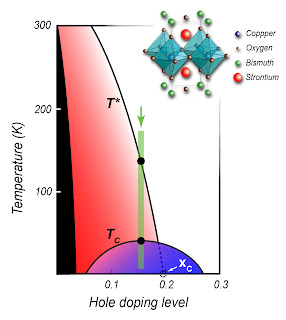In this phase diagram common to many cuprate superconductors, the insulating phase typical of undoped cuprate compounds appears at the far left (black). Other phases appear with increased hole doping – the dome-shaped superconducting phase below Tc (blue), the mysterious pseudogap below T* (red), and a “normal metallic” phase (white). New evidence from studies of Bi2201 (crystal structure inset) along the temperature range shown in greeen strongly supports the idea that the pseudogap is in fact a distinct phase of matter that persists into the superconducting phase. If so the T* phase transition must terminate in a quantum critical point (Xc) at zero temperature. (Click on image for best resolution.)
A collaboration organized by Zhi-Xun Shen, a member of the Stanford Institute for Materials and Energy Science (SIMES) at SLAC and a professor of physics at Stanford University, used three complementary experimental approaches to investigate a single material, the high-temperature superconductor Pb-Bi2201 (lead bismuth strontium lanthanum copper-oxide). Their results are the strongest evidence yet that the pseudogap phase, a mysterious electronic state peculiar to high-temperature superconductors, is not a gradual transition to superconductivity in these materials, as many have long believed. It is in fact a distinct phase of matter.
“This is a paradigm shift in the way we understand high-temperature superconductivity,” says Ruihua He, lead author with Makoto Hashimoto of the paper in the March 25 issue of the journal Science that describes the team’s findings. “The involvement of an additional phase, once fully understood, might open up new possibilities for achieving superconductivity at even higher temperatures in these materials.
Now the three experimental approaches have all been applied to the same material. All yielded consistent results and all point to the same conclusion: there is a phase transition at the pseudogap phase boundary – the three techniques put it precisely at T*. The electronic states dominating the pseudogap phase do not include Cooper pairs, but nevertheless intrude into the lower-lying superconducting phase and directly influence the motion of Cooper pairs in a way previously overlooked.
“Instead of pairing up, the electrons in the pseudogap phase organize themselves in some very different way,” says He. “We currently don’t know what exactly it is, and we don’t know whether it helps superconductivity or hurts it. But we know the direction to take to move forward.”
Says Orenstein, “Coming to grips with a new picture is a little like trying to steer the Titanic, but the fact that all three of these techniques point in the same direction adds to the mounting evidence for the phase change.”
Hussain says the critical factor was bringing the Stanford and Berkeley scientists together. “We joined forces to tackle a more complex problem than any of us had tried on our own.”
The nature of the pseudogap phase of cuprate high-temperature superconductors is a major unsolved problem in condensed matter physics. We studied the commencement of the pseudogap state at temperature T* using three different techniques (angle-resolved photoemission spectroscopy, polar Kerr effect, and time-resolved reflectivity) on the same optimally doped Bi2201 crystals. We observed the coincident, abrupt onset at T* of a particle-hole asymmetric antinodal gap in the electronic spectrum, a Kerr rotation in the reflected light polarization, and a change in the ultrafast relaxational dynamics, consistent with a phase transition. Upon further cooling, spectroscopic signatures of superconductivity begin to grow close to the superconducting transition temperature (Tc), entangled in an energy-momentum–dependent manner with the preexisting pseudogap features, ushering in a ground state with coexisting orders.
25 pages of supplemental material
If you liked this article, please give it a quick review on ycombinator or StumbleUpon. Thanks

Brian Wang is a Futurist Thought Leader and a popular Science blogger with 1 million readers per month. His blog Nextbigfuture.com is ranked #1 Science News Blog. It covers many disruptive technology and trends including Space, Robotics, Artificial Intelligence, Medicine, Anti-aging Biotechnology, and Nanotechnology.
Known for identifying cutting edge technologies, he is currently a Co-Founder of a startup and fundraiser for high potential early-stage companies. He is the Head of Research for Allocations for deep technology investments and an Angel Investor at Space Angels.
A frequent speaker at corporations, he has been a TEDx speaker, a Singularity University speaker and guest at numerous interviews for radio and podcasts. He is open to public speaking and advising engagements.


